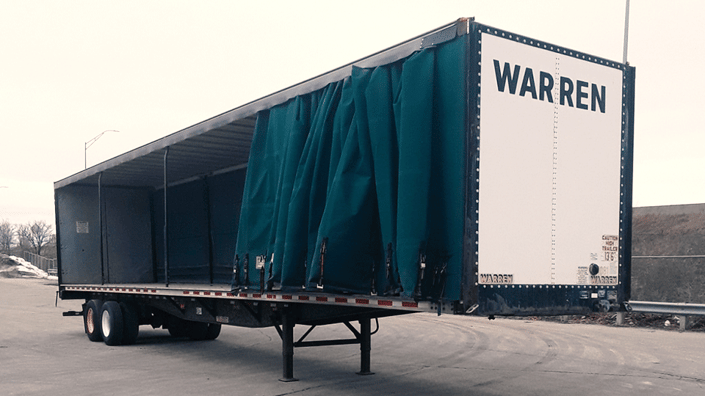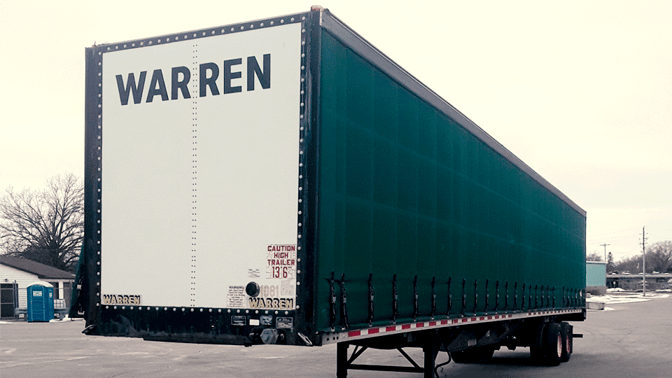
Transportation is an industry full of equipment types. So many equipment types, in fact, that it can sometimes be difficult to understand the use-case of each.
Matching the right trailer to your load is important for facilitating your supply chain.
Yet doing so only gets more challenging with so many options in the mix.
Curtainside trailers are an example of this. This class of semi-trailers is designed for a specific purpose. And, when used correctly, curtainside trailers can become a sound transportation solution.
But what is a curtainside trailer? What are they used most commonly for? And what, if anything, are the limitations of this specialized trailer type?
If you’re looking to add additional trailer options to your logistics procedures, curtainsides may fit the bill. However, it’s important to have all of the right information before making any decisions.
So, let’s go over many of the key details you need to understand about curtainside trailers so you can decide, definitively, whether they will meet your company’s needs.
What is a Curtainside Trailer?
A curtainside trailer is a specialized semi-trailer that has a rigid framework mounted onto a flatbed or flat-deck trailer.
Curtainside trailers are comprised of a firmly bolstered front, which features an entry door, horizontal roof supports running the trailer’s length, a metal constructed roof (similar to a dry van’s), two swing-open rear doors and a sliding tarp system — typically made from an 18-ounce (or similar) material.
The tarps on either side of the curtainside trailer can be retracted for loading, sliding in a similar fashion as the tarps on a Conestoga trailer.

Not to be confused with a Conesoga (though they commonly are), curtainside trailers are different in a number of ways. Most notably, curtainsides only feature tarps on two sides (the left and right). Conestogas have a larger curtain system which creates its roof and rear as well.
Additionally, curtainside trailers feature a far more rigid framework than Conestogas do. The roof of a curtainside trailer is immobile and not retractable — the same cannot be said of Conestogas.
Curtainside trailers come in both 48 and 53-foot variations. Here is a list of the maximum cargo dimensions for this trailer type.
Maximum Cargo Dimensions For Curtainside Trailers
| Maximum Cargo Width | 8 feet, 4 inches (100") |
| Maximum Cargo Height | 8 feet (96") |
| Maximum Cargo Length | 48 and 53 feet |
| Maximum Cargo Weight | 40,000-43,000 pounds |
Note: Maximum cargo dimensions will change based on the make and model of the trailer on your load. Always consult a trusted transportation provider for your exact trailer's dimensions.
How are Curtainside Trailers Commonly Used?
Curtainside trailers can be used for any freight that requires protection from the elements during transport — provided it can be loaded from the side or back.
Products that fit this mold include, but are not limited to, many palletized commodities, raw materials (such as lumber, steel and iron) and moisture-sensitive machinery.
Additionally, since these trailers provide such great protection, traditional dry van commodities like food and beverage freight, general retail goods and hospitality-industry items (to name a few) are also hauled in them.

What Are the Pros and Cons of Using a Curtainside Trailer?
Like any other trailer type, curtainside trailers have a unique list of pros and cons users should be aware of. Compared to its closest alternative, the Conestoga trailer, curtainsides boast the following list of pros and cons:
Advantages of using a curtainside trailer over a Conestoga:
- Better protection from the elements thanks to its tight seams and hard top.
- The durability of an aluminum roof.
Disadvantages of using a curtainside trailer over a Conestoga:
- Curtainsides are heavier, which makes it more challenging to move high-weight, full truckload volumes.
- Due to their rigid framework, curtainside trailers can only be loaded from the sides via forklift or from the back. Loading using an overhead crane won’t be possible.
Looking For Protection From The Elements? Here’s Another Alternative!
Like Conestoga trailers, curtainsides are a relatively unique trailer type, making them difficult to find in some markets and driving up the cost of using one. Sure, curtainside trailers provide excellent protection from the elements and reduce instances of cargo damage during transit, but, in many situations, you simply don’t need one.
Tarping your open-deck freight will leave you with far more solutions to source from, cutting down the rates you pay in many instances.
That said, using tarps instead of one of these more specialized trailers will be a decision that is, once again, based on research.
And, after completing it, feel free to reach out to us with any questions you may have. We’re always happy to help you in any way you need.




